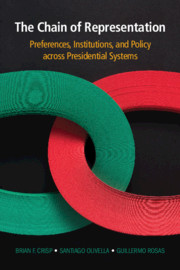Book contents
- Frontmatter
- Contents
- List of Figures
- List of Tables
- Acknowledgements
- Abbreviations
- 1 Studying the Chain of Representation
- 2 Our Solutions to the Challenges of Studying the Chain of Representation
- Part I Stages
- Part II Linkages
- Part III Testing the Chain of Representation
- 9 From Citizens to Policy-Makers
- 10 From Policy-Makers to Policies
- 11 From Citizens to Policies
- 12 A Chain Is Only as Strong as Its Weakest Link
- Appendix Question Wording
- Bibliography
- Author Index
- Subject Index
11 - From Citizens to Policies
from Part III - Testing the Chain of Representation
Published online by Cambridge University Press: 10 January 2020
- Frontmatter
- Contents
- List of Figures
- List of Tables
- Acknowledgements
- Abbreviations
- 1 Studying the Chain of Representation
- 2 Our Solutions to the Challenges of Studying the Chain of Representation
- Part I Stages
- Part II Linkages
- Part III Testing the Chain of Representation
- 9 From Citizens to Policy-Makers
- 10 From Policy-Makers to Policies
- 11 From Citizens to Policies
- 12 A Chain Is Only as Strong as Its Weakest Link
- Appendix Question Wording
- Bibliography
- Author Index
- Subject Index
Summary
In this chapter, we consider the connection between citizens and policies, accounting for all the intermediate linkages that form the full chain of representation. In general, while we find that median and distribution-aware congruences are higher whenever PMPs empower legislatures, such PMPs make it harder for policy to accurately track the movements of citizen moods over time. In turn, while executive-empowering PMPs make it easy for policy to respond to changes in citizen moods (particularly when legislatures are elected under restrictive rules, and presidents are elected under permissive rules), this increased ability comes at the expense of accurately reflecting the preferences of citizens in terms of proximity. We also find, as we did in the previous chapter, that, even where congruence is low, responsiveness can remain high. In other words, citizens’ moods can be reflected in the direction that policy is moving even when that policy remains somewhat distant from what most citizens would prefer.
- Type
- Chapter
- Information
- The Chain of RepresentationPreferences, Institutions, and Policy across Presidential Systems, pp. 212 - 228Publisher: Cambridge University PressPrint publication year: 2020



